Thesis: Comparative Analysis of C&D Waste Management Practices
VerifiedAdded on 2023/06/10
|17
|3312
|194
Thesis and Dissertation
AI Summary
This thesis proposal outlines a comparative case study on construction and demolition (C&D) waste management, focusing on India and comparing its practices with those in the USA and Australia. It highlights the increasing environmental impact of construction activities in India due to rapid urbanization and economic growth. The study aims to analyze and compare waste management practices, including the 3R methods (reduce, reuse, recycle), government regulations, stakeholder awareness programs, and the quantum of waste generation in each country. The proposal identifies gaps in existing research, particularly concerning stakeholder awareness and the implementation of effective waste management systems in India. It seeks to address factors causing current waste generation issues and propose enhancements based on best practices from the case studies, emphasizing the urgency of improving C&D waste management in India to mitigate future environmental impacts.
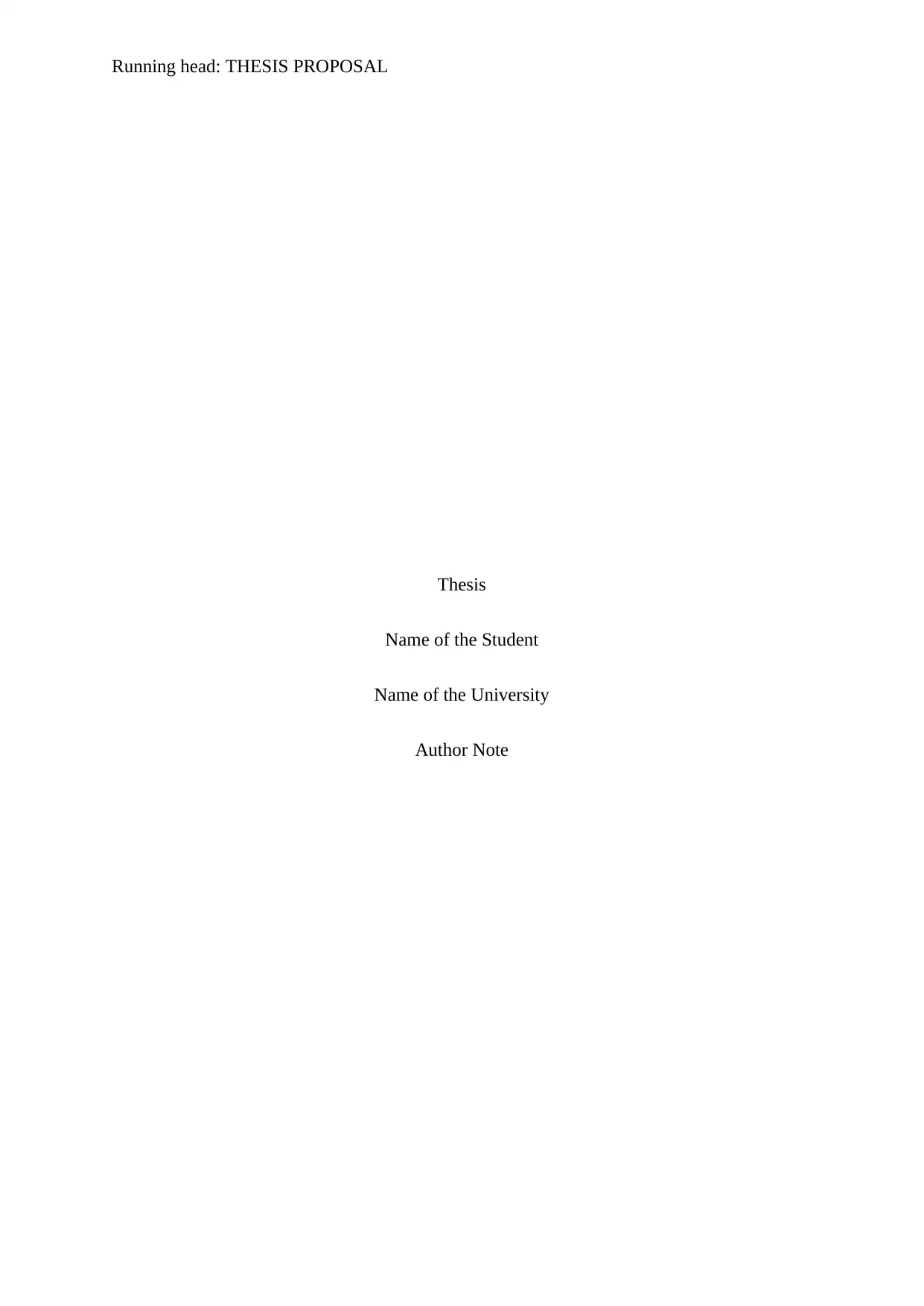
Running head: THESIS PROPOSAL
Thesis
Name of the Student
Name of the University
Author Note
Thesis
Name of the Student
Name of the University
Author Note
Paraphrase This Document
Need a fresh take? Get an instant paraphrase of this document with our AI Paraphraser
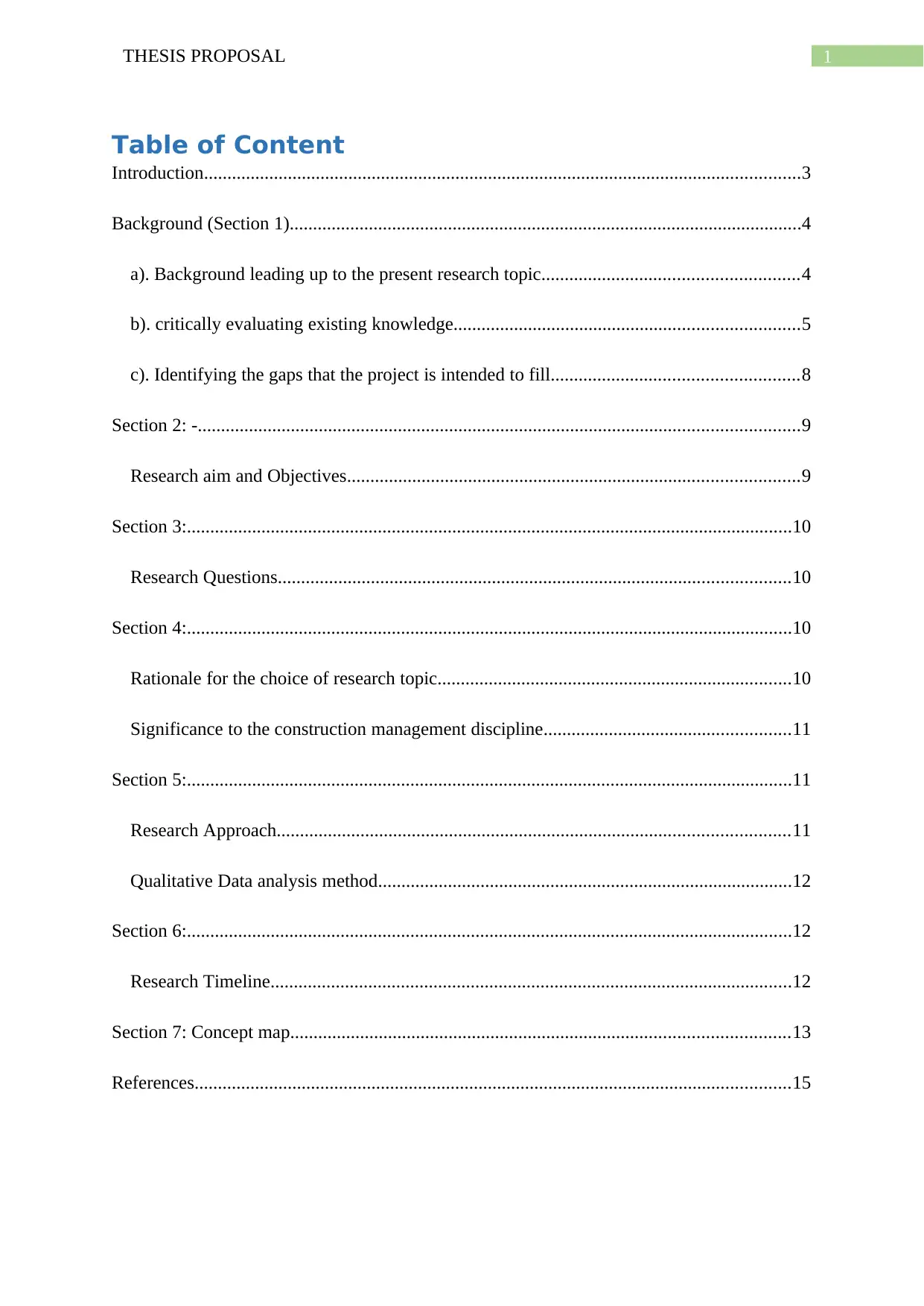
1THESIS PROPOSAL
Table of Content
Introduction................................................................................................................................3
Background (Section 1)..............................................................................................................4
a). Background leading up to the present research topic.......................................................4
b). critically evaluating existing knowledge..........................................................................5
c). Identifying the gaps that the project is intended to fill.....................................................8
Section 2: -.................................................................................................................................9
Research aim and Objectives.................................................................................................9
Section 3:..................................................................................................................................10
Research Questions..............................................................................................................10
Section 4:..................................................................................................................................10
Rationale for the choice of research topic............................................................................10
Significance to the construction management discipline.....................................................11
Section 5:..................................................................................................................................11
Research Approach..............................................................................................................11
Qualitative Data analysis method.........................................................................................12
Section 6:..................................................................................................................................12
Research Timeline................................................................................................................12
Section 7: Concept map...........................................................................................................13
References................................................................................................................................15
Table of Content
Introduction................................................................................................................................3
Background (Section 1)..............................................................................................................4
a). Background leading up to the present research topic.......................................................4
b). critically evaluating existing knowledge..........................................................................5
c). Identifying the gaps that the project is intended to fill.....................................................8
Section 2: -.................................................................................................................................9
Research aim and Objectives.................................................................................................9
Section 3:..................................................................................................................................10
Research Questions..............................................................................................................10
Section 4:..................................................................................................................................10
Rationale for the choice of research topic............................................................................10
Significance to the construction management discipline.....................................................11
Section 5:..................................................................................................................................11
Research Approach..............................................................................................................11
Qualitative Data analysis method.........................................................................................12
Section 6:..................................................................................................................................12
Research Timeline................................................................................................................12
Section 7: Concept map...........................................................................................................13
References................................................................................................................................15

2THESIS PROPOSAL
⊘ This is a preview!⊘
Do you want full access?
Subscribe today to unlock all pages.

Trusted by 1+ million students worldwide
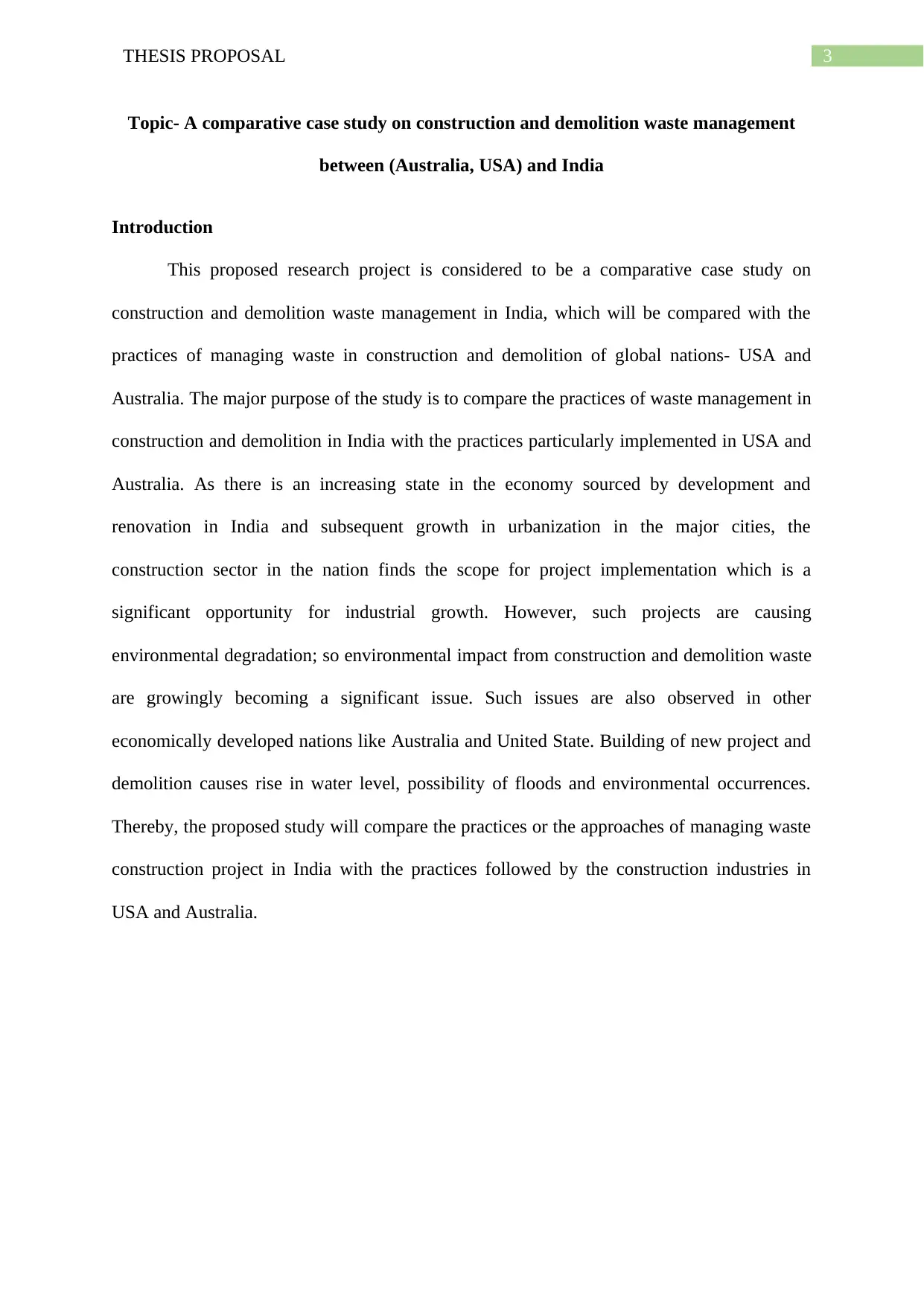
3THESIS PROPOSAL
Topic- A comparative case study on construction and demolition waste management
between (Australia, USA) and India
Introduction
This proposed research project is considered to be a comparative case study on
construction and demolition waste management in India, which will be compared with the
practices of managing waste in construction and demolition of global nations- USA and
Australia. The major purpose of the study is to compare the practices of waste management in
construction and demolition in India with the practices particularly implemented in USA and
Australia. As there is an increasing state in the economy sourced by development and
renovation in India and subsequent growth in urbanization in the major cities, the
construction sector in the nation finds the scope for project implementation which is a
significant opportunity for industrial growth. However, such projects are causing
environmental degradation; so environmental impact from construction and demolition waste
are growingly becoming a significant issue. Such issues are also observed in other
economically developed nations like Australia and United State. Building of new project and
demolition causes rise in water level, possibility of floods and environmental occurrences.
Thereby, the proposed study will compare the practices or the approaches of managing waste
construction project in India with the practices followed by the construction industries in
USA and Australia.
Topic- A comparative case study on construction and demolition waste management
between (Australia, USA) and India
Introduction
This proposed research project is considered to be a comparative case study on
construction and demolition waste management in India, which will be compared with the
practices of managing waste in construction and demolition of global nations- USA and
Australia. The major purpose of the study is to compare the practices of waste management in
construction and demolition in India with the practices particularly implemented in USA and
Australia. As there is an increasing state in the economy sourced by development and
renovation in India and subsequent growth in urbanization in the major cities, the
construction sector in the nation finds the scope for project implementation which is a
significant opportunity for industrial growth. However, such projects are causing
environmental degradation; so environmental impact from construction and demolition waste
are growingly becoming a significant issue. Such issues are also observed in other
economically developed nations like Australia and United State. Building of new project and
demolition causes rise in water level, possibility of floods and environmental occurrences.
Thereby, the proposed study will compare the practices or the approaches of managing waste
construction project in India with the practices followed by the construction industries in
USA and Australia.
Paraphrase This Document
Need a fresh take? Get an instant paraphrase of this document with our AI Paraphraser
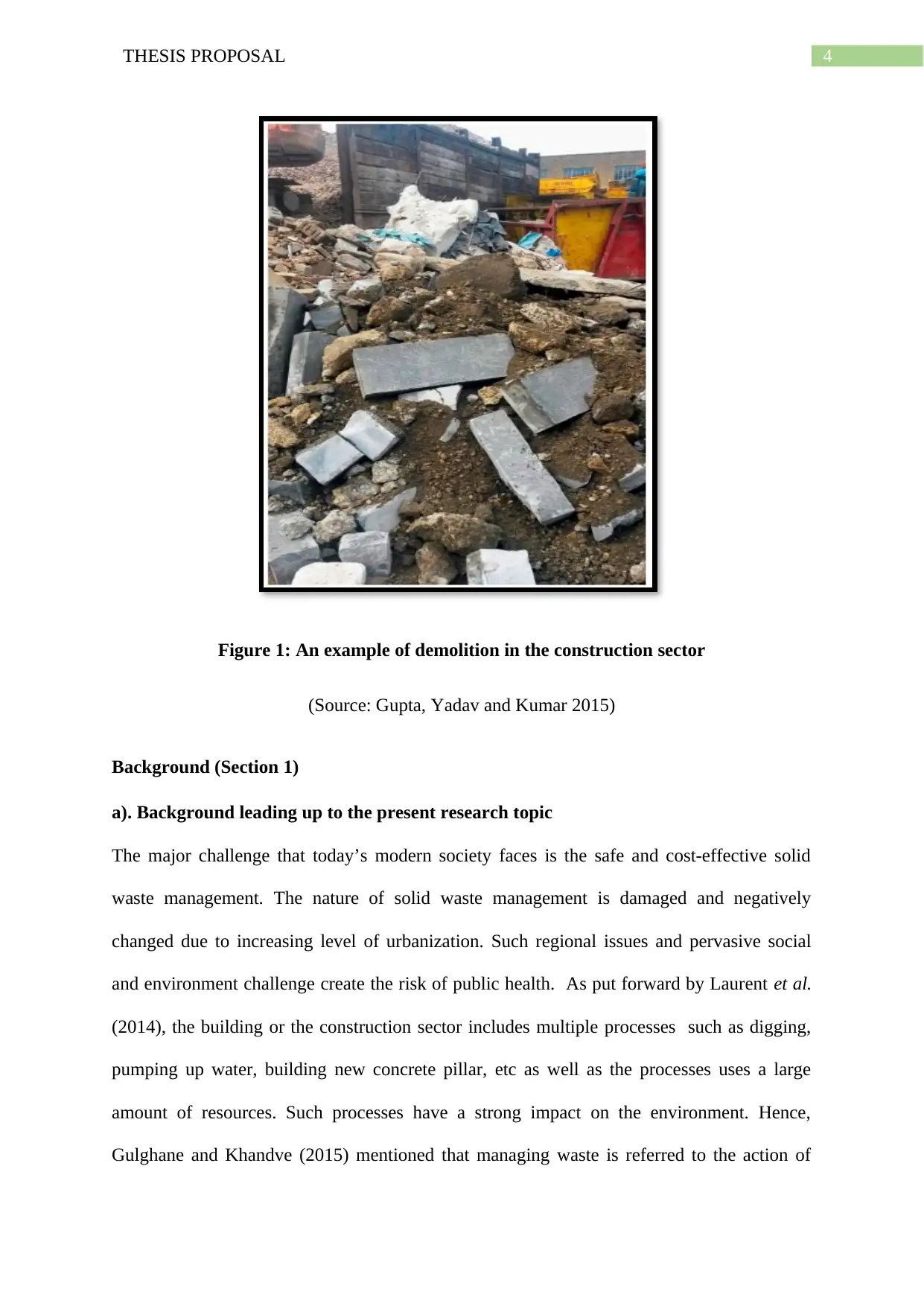
4THESIS PROPOSAL
Figure 1: An example of demolition in the construction sector
(Source: Gupta, Yadav and Kumar 2015)
Background (Section 1)
a). Background leading up to the present research topic
The major challenge that today’s modern society faces is the safe and cost-effective solid
waste management. The nature of solid waste management is damaged and negatively
changed due to increasing level of urbanization. Such regional issues and pervasive social
and environment challenge create the risk of public health. As put forward by Laurent et al.
(2014), the building or the construction sector includes multiple processes such as digging,
pumping up water, building new concrete pillar, etc as well as the processes uses a large
amount of resources. Such processes have a strong impact on the environment. Hence,
Gulghane and Khandve (2015) mentioned that managing waste is referred to the action of
Figure 1: An example of demolition in the construction sector
(Source: Gupta, Yadav and Kumar 2015)
Background (Section 1)
a). Background leading up to the present research topic
The major challenge that today’s modern society faces is the safe and cost-effective solid
waste management. The nature of solid waste management is damaged and negatively
changed due to increasing level of urbanization. Such regional issues and pervasive social
and environment challenge create the risk of public health. As put forward by Laurent et al.
(2014), the building or the construction sector includes multiple processes such as digging,
pumping up water, building new concrete pillar, etc as well as the processes uses a large
amount of resources. Such processes have a strong impact on the environment. Hence,
Gulghane and Khandve (2015) mentioned that managing waste is referred to the action of
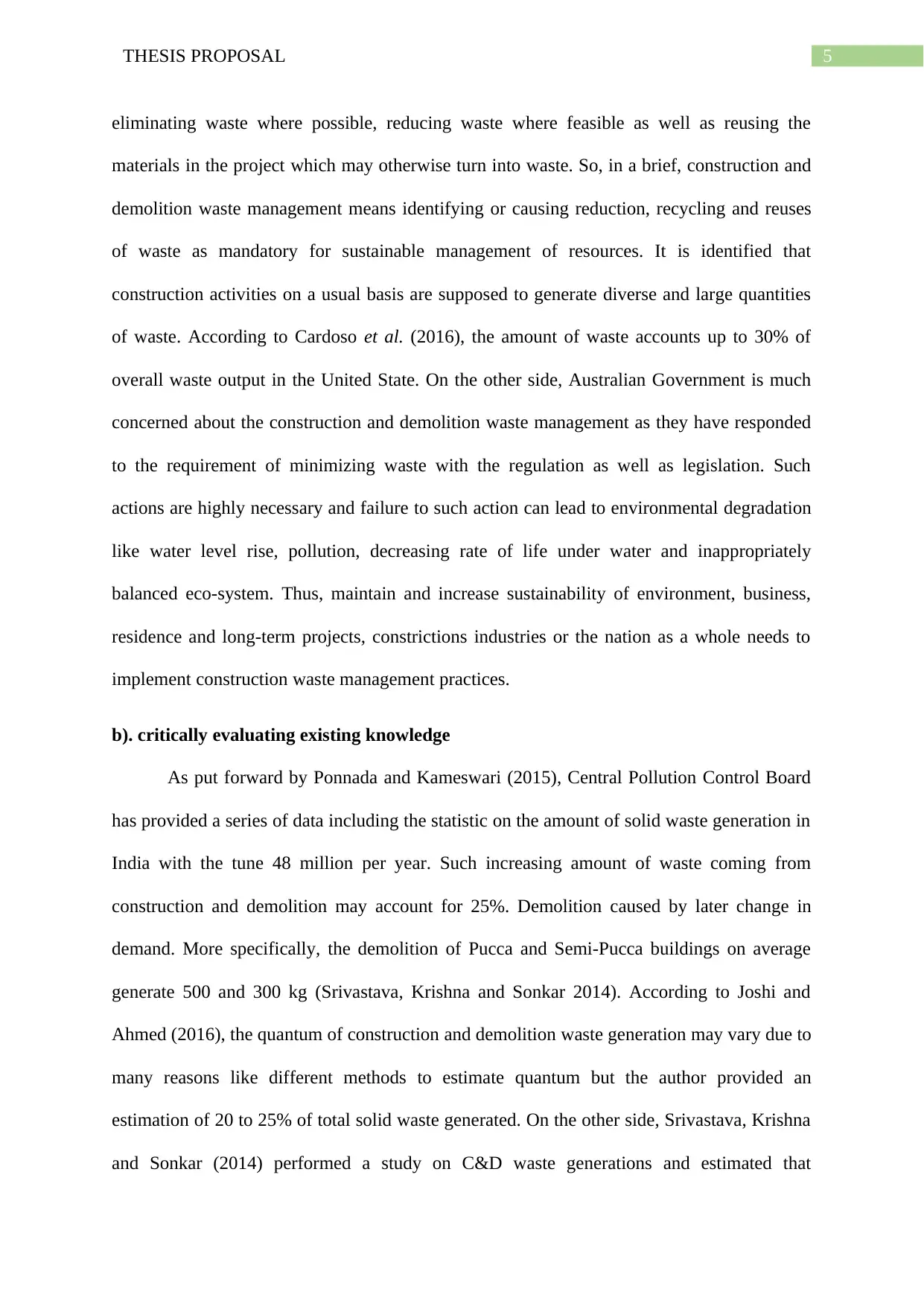
5THESIS PROPOSAL
eliminating waste where possible, reducing waste where feasible as well as reusing the
materials in the project which may otherwise turn into waste. So, in a brief, construction and
demolition waste management means identifying or causing reduction, recycling and reuses
of waste as mandatory for sustainable management of resources. It is identified that
construction activities on a usual basis are supposed to generate diverse and large quantities
of waste. According to Cardoso et al. (2016), the amount of waste accounts up to 30% of
overall waste output in the United State. On the other side, Australian Government is much
concerned about the construction and demolition waste management as they have responded
to the requirement of minimizing waste with the regulation as well as legislation. Such
actions are highly necessary and failure to such action can lead to environmental degradation
like water level rise, pollution, decreasing rate of life under water and inappropriately
balanced eco-system. Thus, maintain and increase sustainability of environment, business,
residence and long-term projects, constrictions industries or the nation as a whole needs to
implement construction waste management practices.
b). critically evaluating existing knowledge
As put forward by Ponnada and Kameswari (2015), Central Pollution Control Board
has provided a series of data including the statistic on the amount of solid waste generation in
India with the tune 48 million per year. Such increasing amount of waste coming from
construction and demolition may account for 25%. Demolition caused by later change in
demand. More specifically, the demolition of Pucca and Semi-Pucca buildings on average
generate 500 and 300 kg (Srivastava, Krishna and Sonkar 2014). According to Joshi and
Ahmed (2016), the quantum of construction and demolition waste generation may vary due to
many reasons like different methods to estimate quantum but the author provided an
estimation of 20 to 25% of total solid waste generated. On the other side, Srivastava, Krishna
and Sonkar (2014) performed a study on C&D waste generations and estimated that
eliminating waste where possible, reducing waste where feasible as well as reusing the
materials in the project which may otherwise turn into waste. So, in a brief, construction and
demolition waste management means identifying or causing reduction, recycling and reuses
of waste as mandatory for sustainable management of resources. It is identified that
construction activities on a usual basis are supposed to generate diverse and large quantities
of waste. According to Cardoso et al. (2016), the amount of waste accounts up to 30% of
overall waste output in the United State. On the other side, Australian Government is much
concerned about the construction and demolition waste management as they have responded
to the requirement of minimizing waste with the regulation as well as legislation. Such
actions are highly necessary and failure to such action can lead to environmental degradation
like water level rise, pollution, decreasing rate of life under water and inappropriately
balanced eco-system. Thus, maintain and increase sustainability of environment, business,
residence and long-term projects, constrictions industries or the nation as a whole needs to
implement construction waste management practices.
b). critically evaluating existing knowledge
As put forward by Ponnada and Kameswari (2015), Central Pollution Control Board
has provided a series of data including the statistic on the amount of solid waste generation in
India with the tune 48 million per year. Such increasing amount of waste coming from
construction and demolition may account for 25%. Demolition caused by later change in
demand. More specifically, the demolition of Pucca and Semi-Pucca buildings on average
generate 500 and 300 kg (Srivastava, Krishna and Sonkar 2014). According to Joshi and
Ahmed (2016), the quantum of construction and demolition waste generation may vary due to
many reasons like different methods to estimate quantum but the author provided an
estimation of 20 to 25% of total solid waste generated. On the other side, Srivastava, Krishna
and Sonkar (2014) performed a study on C&D waste generations and estimated that
⊘ This is a preview!⊘
Do you want full access?
Subscribe today to unlock all pages.

Trusted by 1+ million students worldwide
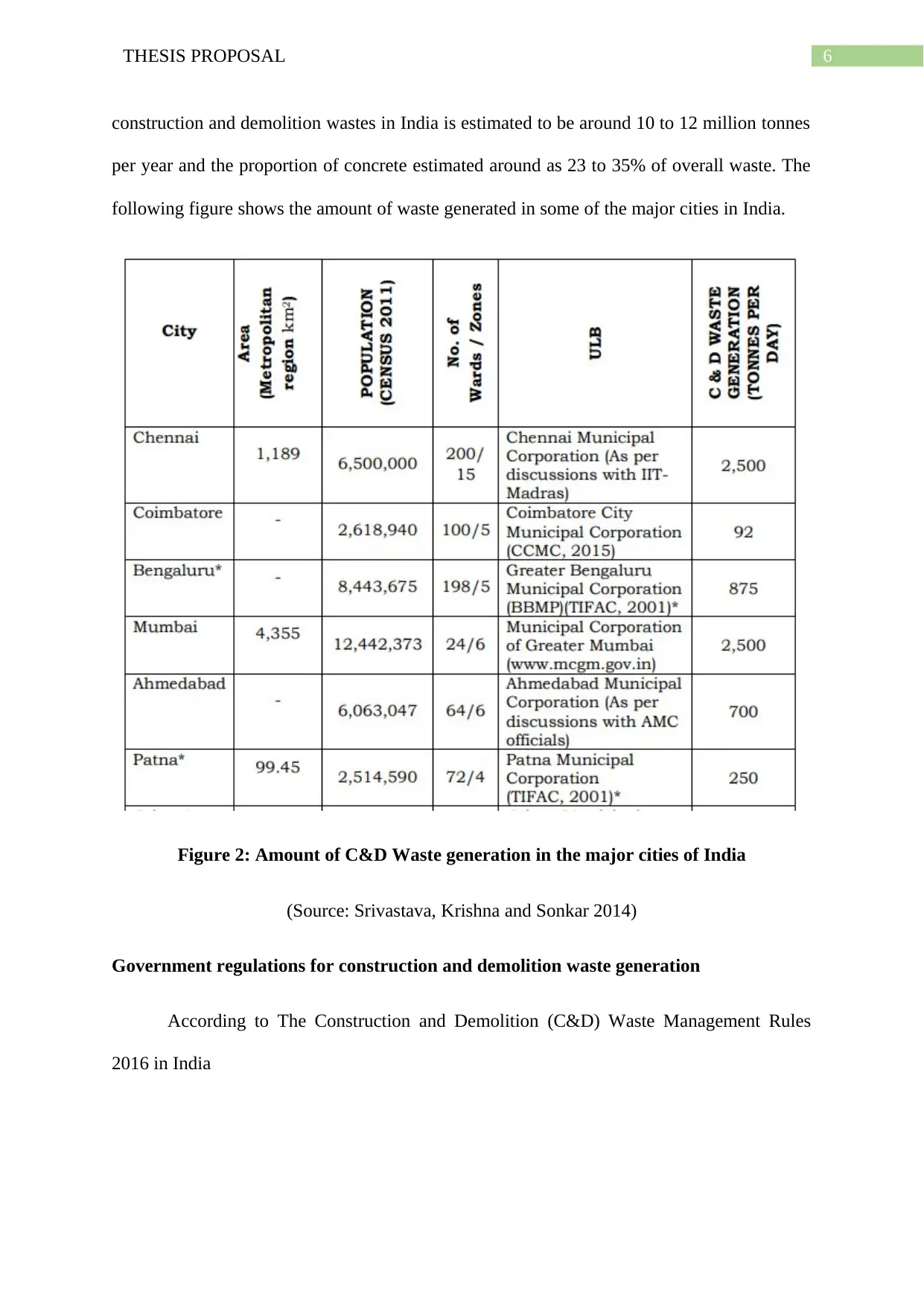
6THESIS PROPOSAL
construction and demolition wastes in India is estimated to be around 10 to 12 million tonnes
per year and the proportion of concrete estimated around as 23 to 35% of overall waste. The
following figure shows the amount of waste generated in some of the major cities in India.
Figure 2: Amount of C&D Waste generation in the major cities of India
(Source: Srivastava, Krishna and Sonkar 2014)
Government regulations for construction and demolition waste generation
According to The Construction and Demolition (C&D) Waste Management Rules
2016 in India
construction and demolition wastes in India is estimated to be around 10 to 12 million tonnes
per year and the proportion of concrete estimated around as 23 to 35% of overall waste. The
following figure shows the amount of waste generated in some of the major cities in India.
Figure 2: Amount of C&D Waste generation in the major cities of India
(Source: Srivastava, Krishna and Sonkar 2014)
Government regulations for construction and demolition waste generation
According to The Construction and Demolition (C&D) Waste Management Rules
2016 in India
Paraphrase This Document
Need a fresh take? Get an instant paraphrase of this document with our AI Paraphraser
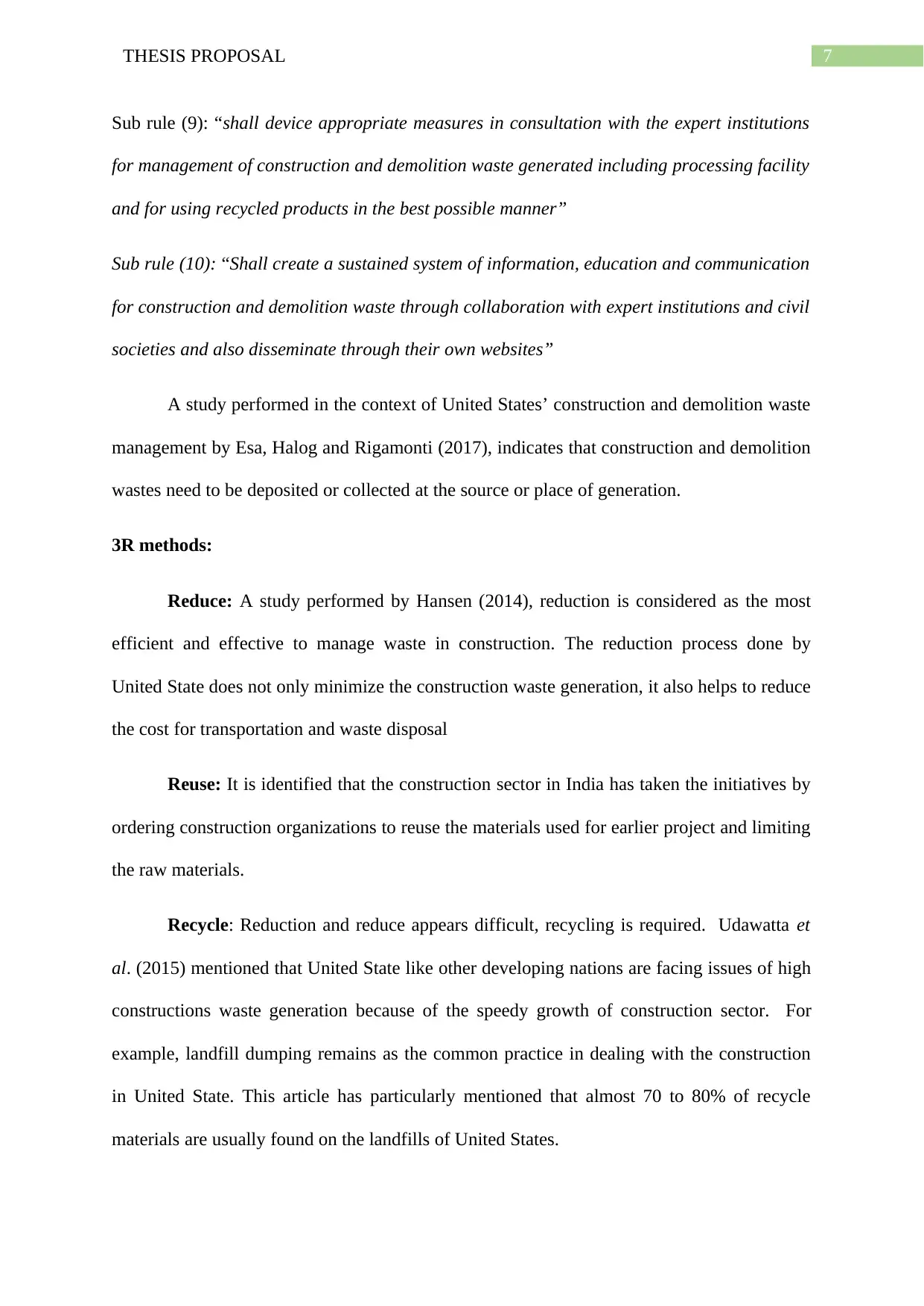
7THESIS PROPOSAL
Sub rule (9): “shall device appropriate measures in consultation with the expert institutions
for management of construction and demolition waste generated including processing facility
and for using recycled products in the best possible manner”
Sub rule (10): “Shall create a sustained system of information, education and communication
for construction and demolition waste through collaboration with expert institutions and civil
societies and also disseminate through their own websites”
A study performed in the context of United States’ construction and demolition waste
management by Esa, Halog and Rigamonti (2017), indicates that construction and demolition
wastes need to be deposited or collected at the source or place of generation.
3R methods:
Reduce: A study performed by Hansen (2014), reduction is considered as the most
efficient and effective to manage waste in construction. The reduction process done by
United State does not only minimize the construction waste generation, it also helps to reduce
the cost for transportation and waste disposal
Reuse: It is identified that the construction sector in India has taken the initiatives by
ordering construction organizations to reuse the materials used for earlier project and limiting
the raw materials.
Recycle: Reduction and reduce appears difficult, recycling is required. Udawatta et
al. (2015) mentioned that United State like other developing nations are facing issues of high
constructions waste generation because of the speedy growth of construction sector. For
example, landfill dumping remains as the common practice in dealing with the construction
in United State. This article has particularly mentioned that almost 70 to 80% of recycle
materials are usually found on the landfills of United States.
Sub rule (9): “shall device appropriate measures in consultation with the expert institutions
for management of construction and demolition waste generated including processing facility
and for using recycled products in the best possible manner”
Sub rule (10): “Shall create a sustained system of information, education and communication
for construction and demolition waste through collaboration with expert institutions and civil
societies and also disseminate through their own websites”
A study performed in the context of United States’ construction and demolition waste
management by Esa, Halog and Rigamonti (2017), indicates that construction and demolition
wastes need to be deposited or collected at the source or place of generation.
3R methods:
Reduce: A study performed by Hansen (2014), reduction is considered as the most
efficient and effective to manage waste in construction. The reduction process done by
United State does not only minimize the construction waste generation, it also helps to reduce
the cost for transportation and waste disposal
Reuse: It is identified that the construction sector in India has taken the initiatives by
ordering construction organizations to reuse the materials used for earlier project and limiting
the raw materials.
Recycle: Reduction and reduce appears difficult, recycling is required. Udawatta et
al. (2015) mentioned that United State like other developing nations are facing issues of high
constructions waste generation because of the speedy growth of construction sector. For
example, landfill dumping remains as the common practice in dealing with the construction
in United State. This article has particularly mentioned that almost 70 to 80% of recycle
materials are usually found on the landfills of United States.

8THESIS PROPOSAL
Stakeholder awareness
The governments in India is much concerned about the awareness programs for
increasing waste in construction and demolition. The following chart shows the type of
stakeholders involved in the process and their roles in creating awareness.
Figure 3: Stakeholders involved in creating awareness for C&D waste management
(Source: Srivastava, Krishna and Sonkar 2014)
The execution of the rules required a proper insight of the activities which is to be
performed by each of these stakeholders as well as comprehension of interdependency on
each other. For example, the central governments of the nation are supposed to monitor
implementation of regional policy and action plan and lead the execution, evaluate the issues
being faced and deliver direction in implementation.
c). Identifying the gaps that the project is intended to fill
It has been identified that existing papers on construction and demolition waste
management did not show much concerns towards the awareness of waste management in
construction and demolition. However, Australia in this contest is a step ahead, as they have
developed a broad set of rules covering mandatory rules of reuse and recycle of materials.
Stakeholder awareness
The governments in India is much concerned about the awareness programs for
increasing waste in construction and demolition. The following chart shows the type of
stakeholders involved in the process and their roles in creating awareness.
Figure 3: Stakeholders involved in creating awareness for C&D waste management
(Source: Srivastava, Krishna and Sonkar 2014)
The execution of the rules required a proper insight of the activities which is to be
performed by each of these stakeholders as well as comprehension of interdependency on
each other. For example, the central governments of the nation are supposed to monitor
implementation of regional policy and action plan and lead the execution, evaluate the issues
being faced and deliver direction in implementation.
c). Identifying the gaps that the project is intended to fill
It has been identified that existing papers on construction and demolition waste
management did not show much concerns towards the awareness of waste management in
construction and demolition. However, Australia in this contest is a step ahead, as they have
developed a broad set of rules covering mandatory rules of reuse and recycle of materials.
⊘ This is a preview!⊘
Do you want full access?
Subscribe today to unlock all pages.

Trusted by 1+ million students worldwide
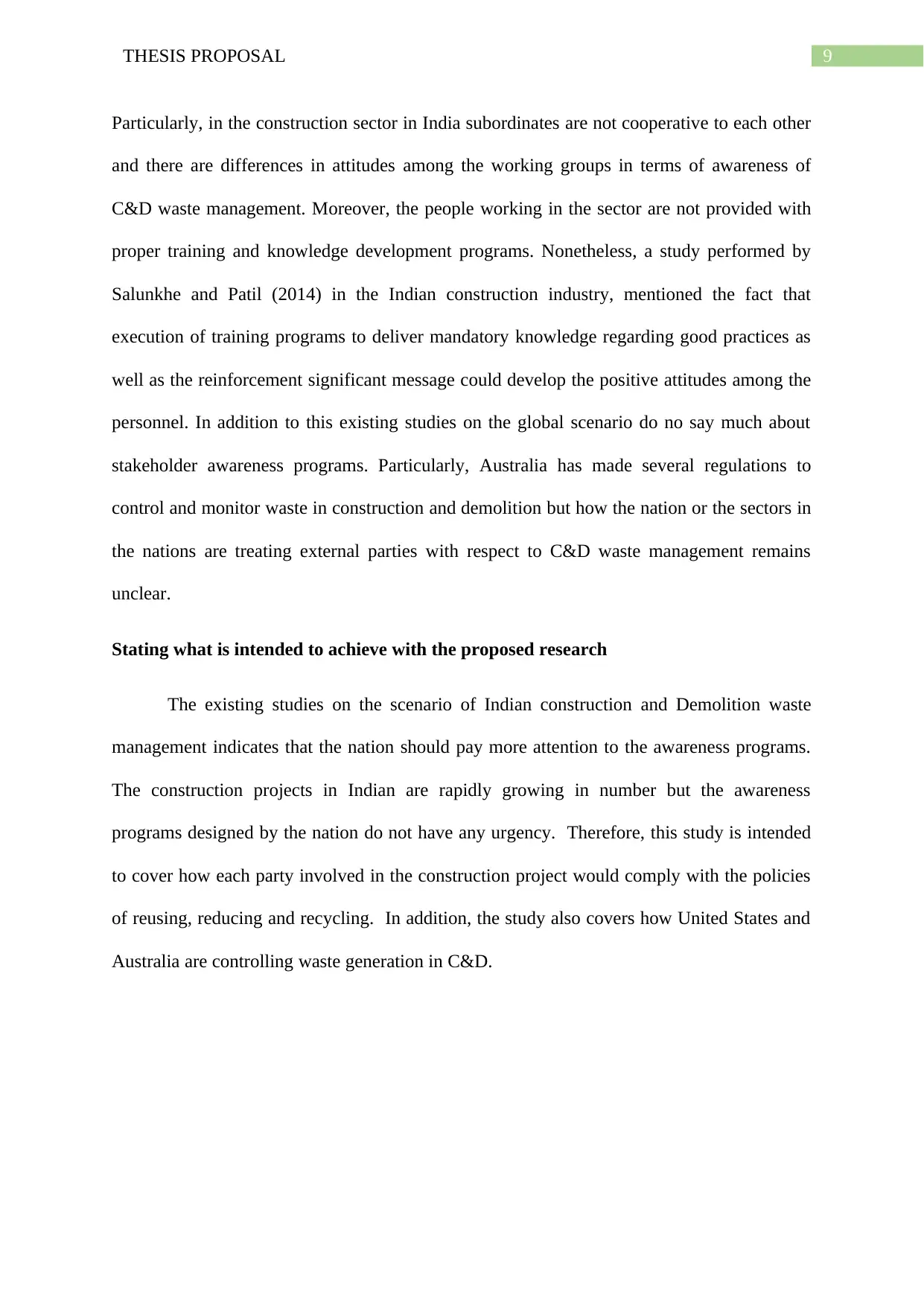
9THESIS PROPOSAL
Particularly, in the construction sector in India subordinates are not cooperative to each other
and there are differences in attitudes among the working groups in terms of awareness of
C&D waste management. Moreover, the people working in the sector are not provided with
proper training and knowledge development programs. Nonetheless, a study performed by
Salunkhe and Patil (2014) in the Indian construction industry, mentioned the fact that
execution of training programs to deliver mandatory knowledge regarding good practices as
well as the reinforcement significant message could develop the positive attitudes among the
personnel. In addition to this existing studies on the global scenario do no say much about
stakeholder awareness programs. Particularly, Australia has made several regulations to
control and monitor waste in construction and demolition but how the nation or the sectors in
the nations are treating external parties with respect to C&D waste management remains
unclear.
Stating what is intended to achieve with the proposed research
The existing studies on the scenario of Indian construction and Demolition waste
management indicates that the nation should pay more attention to the awareness programs.
The construction projects in Indian are rapidly growing in number but the awareness
programs designed by the nation do not have any urgency. Therefore, this study is intended
to cover how each party involved in the construction project would comply with the policies
of reusing, reducing and recycling. In addition, the study also covers how United States and
Australia are controlling waste generation in C&D.
Particularly, in the construction sector in India subordinates are not cooperative to each other
and there are differences in attitudes among the working groups in terms of awareness of
C&D waste management. Moreover, the people working in the sector are not provided with
proper training and knowledge development programs. Nonetheless, a study performed by
Salunkhe and Patil (2014) in the Indian construction industry, mentioned the fact that
execution of training programs to deliver mandatory knowledge regarding good practices as
well as the reinforcement significant message could develop the positive attitudes among the
personnel. In addition to this existing studies on the global scenario do no say much about
stakeholder awareness programs. Particularly, Australia has made several regulations to
control and monitor waste in construction and demolition but how the nation or the sectors in
the nations are treating external parties with respect to C&D waste management remains
unclear.
Stating what is intended to achieve with the proposed research
The existing studies on the scenario of Indian construction and Demolition waste
management indicates that the nation should pay more attention to the awareness programs.
The construction projects in Indian are rapidly growing in number but the awareness
programs designed by the nation do not have any urgency. Therefore, this study is intended
to cover how each party involved in the construction project would comply with the policies
of reusing, reducing and recycling. In addition, the study also covers how United States and
Australia are controlling waste generation in C&D.
Paraphrase This Document
Need a fresh take? Get an instant paraphrase of this document with our AI Paraphraser
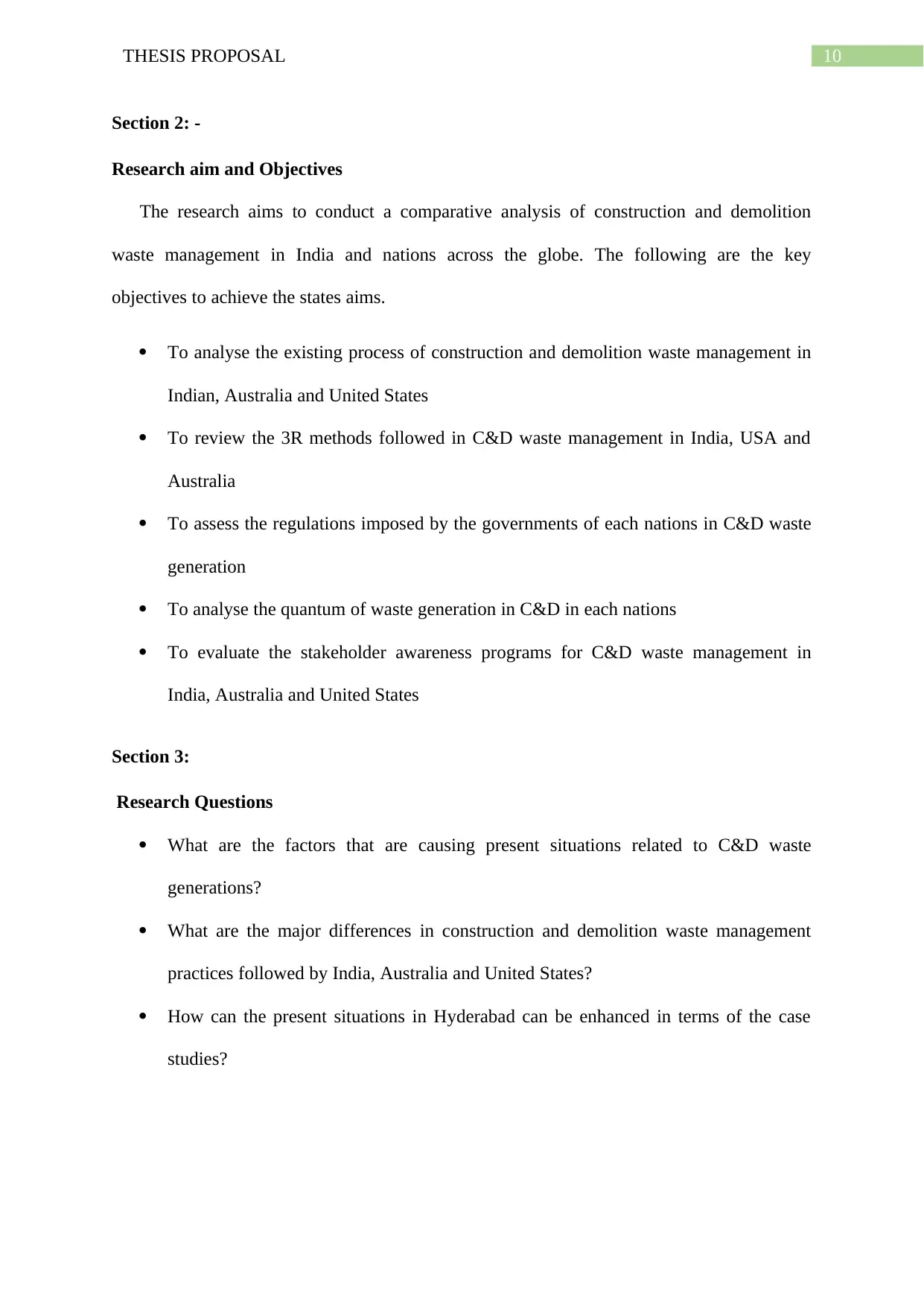
10THESIS PROPOSAL
Section 2: -
Research aim and Objectives
The research aims to conduct a comparative analysis of construction and demolition
waste management in India and nations across the globe. The following are the key
objectives to achieve the states aims.
To analyse the existing process of construction and demolition waste management in
Indian, Australia and United States
To review the 3R methods followed in C&D waste management in India, USA and
Australia
To assess the regulations imposed by the governments of each nations in C&D waste
generation
To analyse the quantum of waste generation in C&D in each nations
To evaluate the stakeholder awareness programs for C&D waste management in
India, Australia and United States
Section 3:
Research Questions
What are the factors that are causing present situations related to C&D waste
generations?
What are the major differences in construction and demolition waste management
practices followed by India, Australia and United States?
How can the present situations in Hyderabad can be enhanced in terms of the case
studies?
Section 2: -
Research aim and Objectives
The research aims to conduct a comparative analysis of construction and demolition
waste management in India and nations across the globe. The following are the key
objectives to achieve the states aims.
To analyse the existing process of construction and demolition waste management in
Indian, Australia and United States
To review the 3R methods followed in C&D waste management in India, USA and
Australia
To assess the regulations imposed by the governments of each nations in C&D waste
generation
To analyse the quantum of waste generation in C&D in each nations
To evaluate the stakeholder awareness programs for C&D waste management in
India, Australia and United States
Section 3:
Research Questions
What are the factors that are causing present situations related to C&D waste
generations?
What are the major differences in construction and demolition waste management
practices followed by India, Australia and United States?
How can the present situations in Hyderabad can be enhanced in terms of the case
studies?
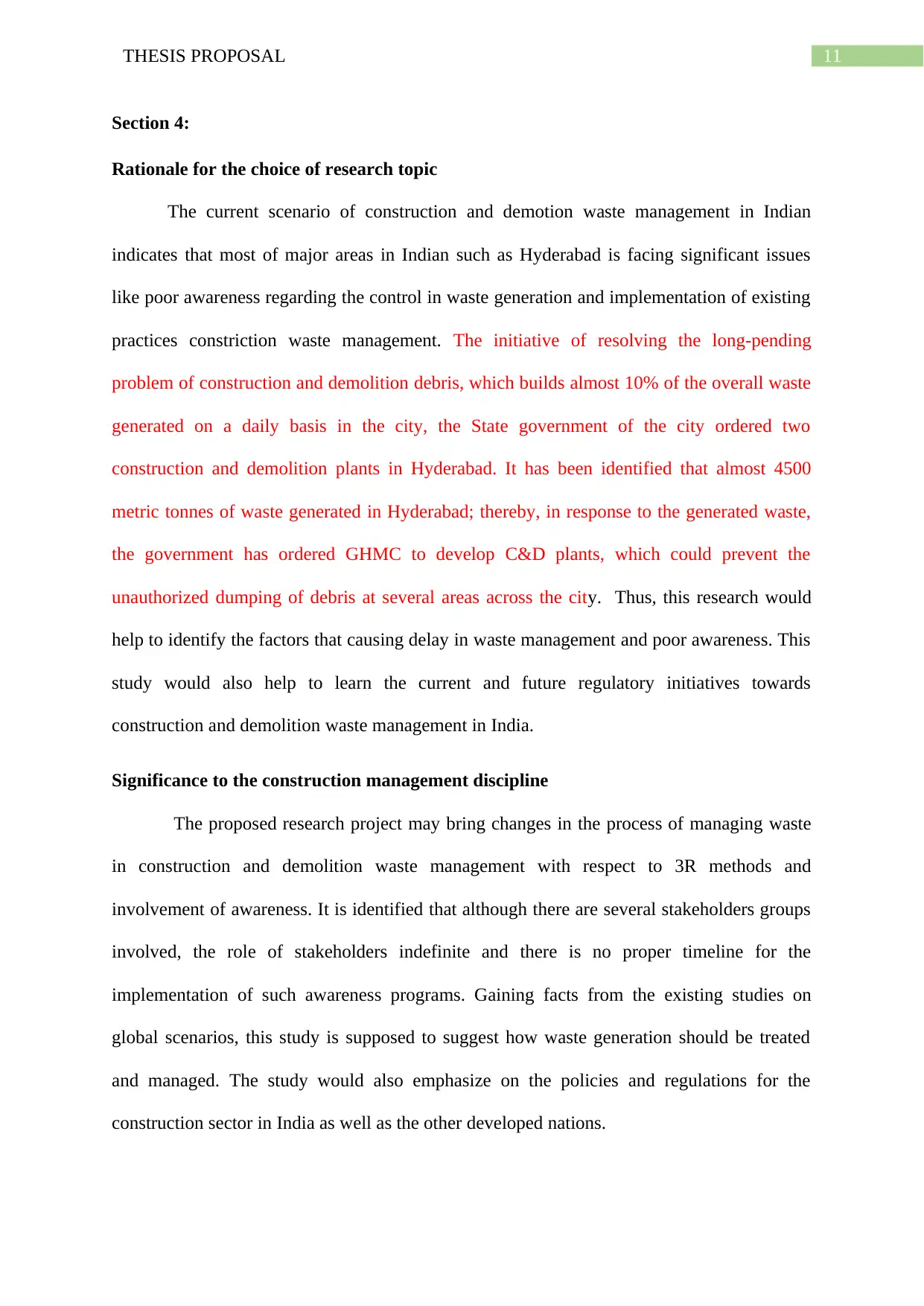
11THESIS PROPOSAL
Section 4:
Rationale for the choice of research topic
The current scenario of construction and demotion waste management in Indian
indicates that most of major areas in Indian such as Hyderabad is facing significant issues
like poor awareness regarding the control in waste generation and implementation of existing
practices constriction waste management. The initiative of resolving the long-pending
problem of construction and demolition debris, which builds almost 10% of the overall waste
generated on a daily basis in the city, the State government of the city ordered two
construction and demolition plants in Hyderabad. It has been identified that almost 4500
metric tonnes of waste generated in Hyderabad; thereby, in response to the generated waste,
the government has ordered GHMC to develop C&D plants, which could prevent the
unauthorized dumping of debris at several areas across the city. Thus, this research would
help to identify the factors that causing delay in waste management and poor awareness. This
study would also help to learn the current and future regulatory initiatives towards
construction and demolition waste management in India.
Significance to the construction management discipline
The proposed research project may bring changes in the process of managing waste
in construction and demolition waste management with respect to 3R methods and
involvement of awareness. It is identified that although there are several stakeholders groups
involved, the role of stakeholders indefinite and there is no proper timeline for the
implementation of such awareness programs. Gaining facts from the existing studies on
global scenarios, this study is supposed to suggest how waste generation should be treated
and managed. The study would also emphasize on the policies and regulations for the
construction sector in India as well as the other developed nations.
Section 4:
Rationale for the choice of research topic
The current scenario of construction and demotion waste management in Indian
indicates that most of major areas in Indian such as Hyderabad is facing significant issues
like poor awareness regarding the control in waste generation and implementation of existing
practices constriction waste management. The initiative of resolving the long-pending
problem of construction and demolition debris, which builds almost 10% of the overall waste
generated on a daily basis in the city, the State government of the city ordered two
construction and demolition plants in Hyderabad. It has been identified that almost 4500
metric tonnes of waste generated in Hyderabad; thereby, in response to the generated waste,
the government has ordered GHMC to develop C&D plants, which could prevent the
unauthorized dumping of debris at several areas across the city. Thus, this research would
help to identify the factors that causing delay in waste management and poor awareness. This
study would also help to learn the current and future regulatory initiatives towards
construction and demolition waste management in India.
Significance to the construction management discipline
The proposed research project may bring changes in the process of managing waste
in construction and demolition waste management with respect to 3R methods and
involvement of awareness. It is identified that although there are several stakeholders groups
involved, the role of stakeholders indefinite and there is no proper timeline for the
implementation of such awareness programs. Gaining facts from the existing studies on
global scenarios, this study is supposed to suggest how waste generation should be treated
and managed. The study would also emphasize on the policies and regulations for the
construction sector in India as well as the other developed nations.
⊘ This is a preview!⊘
Do you want full access?
Subscribe today to unlock all pages.

Trusted by 1+ million students worldwide
1 out of 17